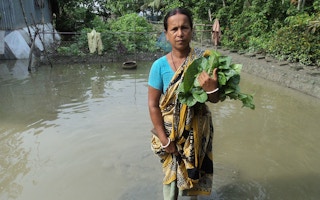Even before we come to end of the year we already know that 2017 will be one of the warmest years on record and we have seen a succession of extreme weather events around the world, including typhoons in the Pacific and hurricanes in the Atlantic as well as floods in South Asia and China and wildfires in California.
Scientists studying these events are now unequivocally able to attribute their enhanced intensity to higher-than-normal atmospheric and ocean temperatures due to human induced climate change.
That means it is clear now that even if human-induced climate change does not cause these weather events, they get greatly exacerbated due to elevated temperatures—and the actual loss and damage that results is now attributable, at least in part, to human-induced climate change.
I will pick on two separate sets of such events to highlight the issue. The first is the flooding that took place in Bangladesh earlier this year which caused an estimated loss and damage to crops and infrastructure of between $3 billion and $5 billion.
Bangladesh is a country that sits in the delta of two of the world’s greatest rivers, namely the Ganges and Brahmaputra which flood during the monsoon season each year.
The people are well adapted to living with this by building their homes on raised hillocks and planting crops like rice and jute that can grow even in partly flooded lands. They are usually able to harvest their crops before the floods and then take out their boats and fish once the main flood waters arrive and inundate the entire floodplain.
We also have very good records, going back several centuries, of the abnormally large floods that occur every now and again. Hence the one-in-20-year flood has occurred more or less every 20 years for centuries. But now it has occurred four times in the last 20 years. And this year’s flood was estimated to be a one-in-100-year event.
Hence it is reasonable to say that while Bangladesh is relatively well adapted to normal floods we are now facing a new-normal of climate change-induced events of much greater magnitude.
My second example is the series of severe hurricanes that hit Texas (Hurricane Harvey), Florida (Hurricane Irma) and Puerto Rico (Hurricane Maria) in quick succession causing severe impacts in all those places.
Again the fact that the hurricanes occurred was not due to climate change but their relatively high severity was clearly due to the higher-than-normal sea surface temperatures at the time.
The estimates of the loss and damage in Texas, Florida and Puerto Rico is said to be over $300 billion, which they will ask the US Congress to pay as part of post-disaster reconstruction.
The US Congress is likely to pay some, if not all, of that bill for loss and damage.
This is because the United States, like many other federal governments, allows states to claim post-disaster compensation from the central government.
But who should Bangladesh send its bill to?
The answer is actually quite clear in the mandate of the Warsaw International Mechanism (WIM) on Loss and Damage, which the UN Framework Convention on Climate Change adopted nearly five years ago in 2013 at COP19.
“
Even if human-induced climate change does not cause these weather events, they get greatly exacerbated due to elevated temperatures—and the actual loss and damage that results is now attributable to human-induced climate change.
The WIM is supposed to address the issue of loss and damage through enhancing our understanding and examining options for addressing loss and damage, including looking for innovative financing options. So far the only option for raising financing has been insurance. However insurance, while useful, is not feasible everywhere, and is not suited to help the poorest and most vulnerable.
Hence the time is now ripe for parties at COP23, under the Presidency of Fiji, to take the next step towards looking at more innovative sources of financing loss and damage.
One idea from civil society that is worth examining seriously is applying the polluter-pays-principle to the handful of giant fossil fuel companies who make enormous profits from selling pollutants, by putting a loss and damage tax or levy on their profits.
This would generate billions of dollars and could be collected by each government in which the company is registered and the funds put into a new global loss and damage fund.
Dr Saleemul Huq is the Director of the International Centre for Climate Change & Development. This story was published with permission from Thomson Reuters Foundation, the charitable arm of Thomson Reuters, that covers humanitarian news, women’s rights, corruption and climate change. Visit news.trust.org.











